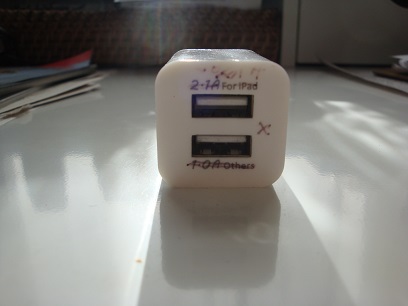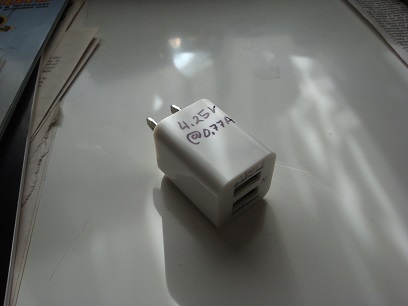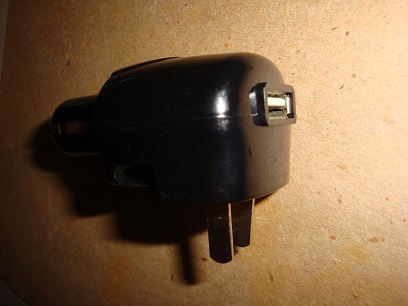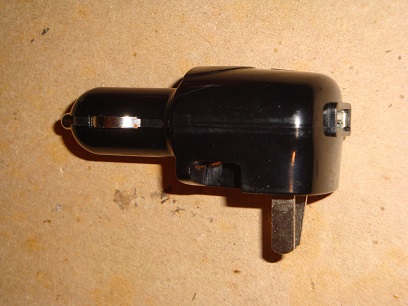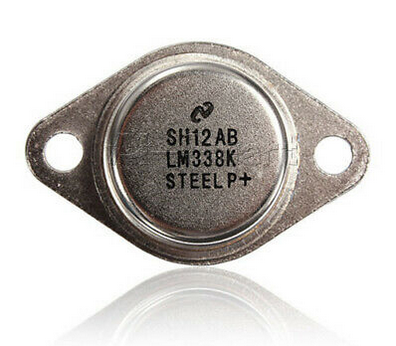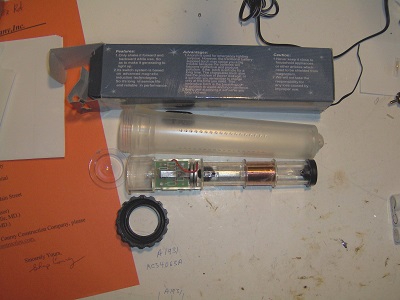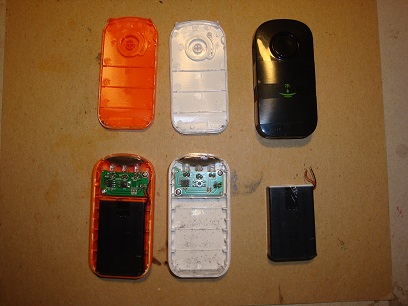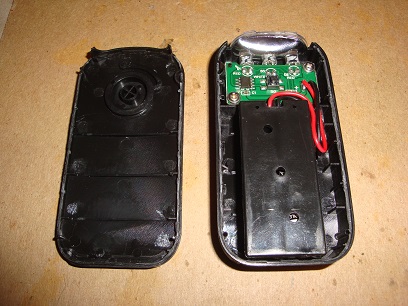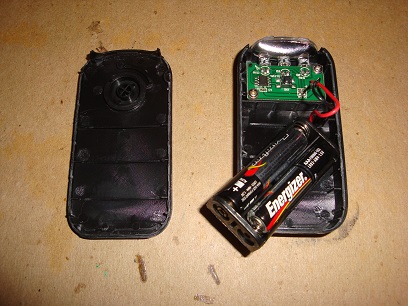This article follows one I finished up in September 2019 about "Battery Pack
Failure Modes I have Known" which was published in
Nuts and Volts Digital Edition in late
2020. See:
Battery Pack Failure Modes I Have Known
At Ham fests I have found a few bogus products that were built in China and
sold under a claim that turned out (to put it more generously) more hopeful
than justified.
Products:
-
Undercurrent USB AC-to-DC converters claiming >= 2 Amps, but they could only
achieve between 100 mA to 1 Amp, max. (image: Little square AC, USB block)
-
Undercurrent USB AC/DC-to-USB DC power converters claiming one, or more than one,
Amp, but they could only achieve 100 mA, max. (image/link)
-
Electronic parts, such as the LM338, a linear adjustable voltage regulator. The
LM338K Adjustable Voltage Regulators, 1.2V to 32V up to 3-5 Amps, from China that I
received, were only able to supply one Amp and would burn out at anything more than
one Amp.
-
Shake-to-Recharge Flashlight, supposed to charge when shaken but was really
using a battery and there was no recharging circuit at all. (See: To or Not to be a
Magnetically Induced Rechargeable Flashlight? - 10/13/2006
http://cs.yrex.com/ke3fl/htm/BogusFlashlight.htm)
-
Bogus Li rechargeable batteries. Some of the claims were to mAh rates higher
than 10,000 mAh.
see:
"Lithium Batteries are NOT all Created Equal!" - 01/25/2018
-
Liquid Battery Flashlight. This water-powered flashlight did not work
as advertised.
-
Bogus Cranking Rechargeable Flashlight, found recently on Amazon at:
https://smile.amazon.com/gp/product/B0869KWX2H - "BFVV Hand Crank Flashlight Emergency Rechargeable LED Flashlight Immediate Torch Light for Camping Outdoor Sports 4 Pack" These flashlights would not recharge when cranked.
-
Bogus Power-Saver Boxes - These are all over the Internet with many false
claims of being able to save you money on your electric bill. Examples can
be found on Amazon at:
Power-Savers
-
Li AA 1.5V 1900 mWh (about 1667 mAh) USB rechargeable batteries. The
product is: SPYONG: "Rechargeable AA Li-ion Batteries 10 Pack with USB
Charging Port, 1.5V 1900mWh High Capacity USB AA Rechargeable Batteries,
Constant Output Li-ion Double a Batteries Cycle Times up to 1500x"
SPYONG/HLAND on Amazon
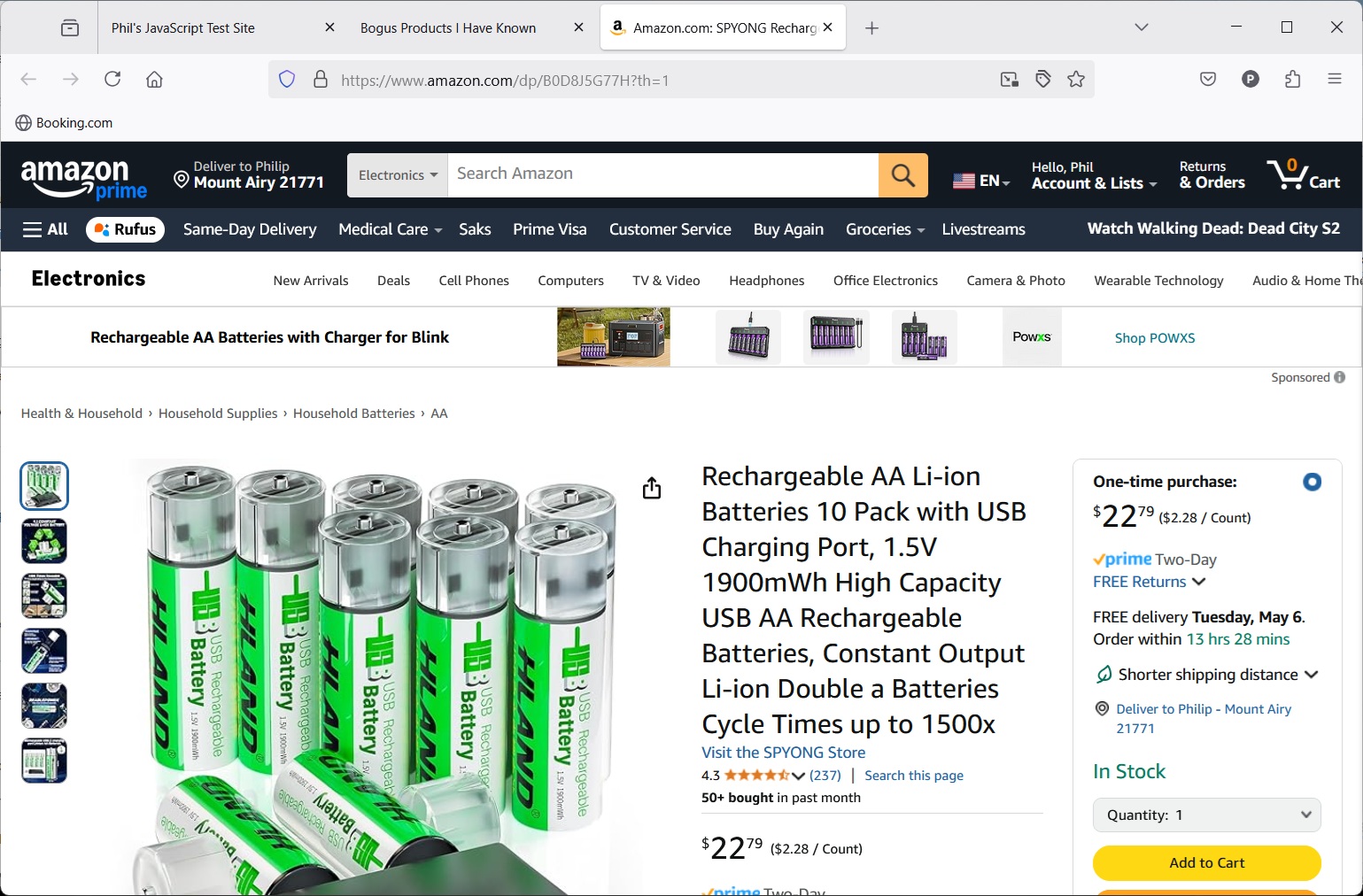
So, for $22.79 plus sales tax each
battery costs about $2.42 each with my 6% sales tax.
More:
SPYONG "HLAND" AA Li Battery Tests
I'll briefly talk about all of these and if I've written a longer explanation
of tests and results, I'll have links to those pages.
-
Undercurrent USB AC-to-DC converters: In this case, many of these sold by
numerous vendors at several Hamfests I attended. In one case, I bought a few from
one vendor and found the converters did not work as expected. I then
tested this first batch and found they could not produce the current
claimed. The next year I found the same vendor selling the same product
and discussed my tests and results. He refunded my money and took the
remaining items off his table until he could test them himself. He later
emailed me that he confirmed my results and managed to get his money back
from the Chinese supplier for the product he still had. These units looked
like small square boxes and had "2 or 2.1 A" printed next to one of the two
USB ports.
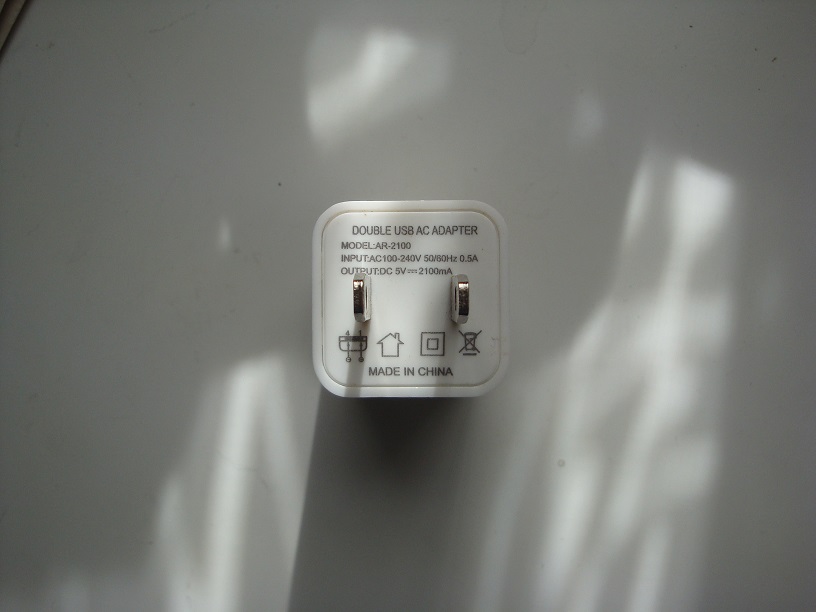
-
I bought ten AC/DC to 5V USB converters directly from China. These would
have been perfect as gifts, except that they claimed iPhone current, at
the time around one Amp. This claim was overly optimistic. These units
could be plugged into the wall for 120Volt AC use or into the car 12-Volt
socket for DC use. Unfortunately, they only produced, at best, 100 mA. I
got my money back from the supplier. They also sent me 10 replacements
after I returned the first ten. Some of these I sold as 100 mA USB power
sources, and a few others I still use for things like filtering LED
Christmas candle lights.
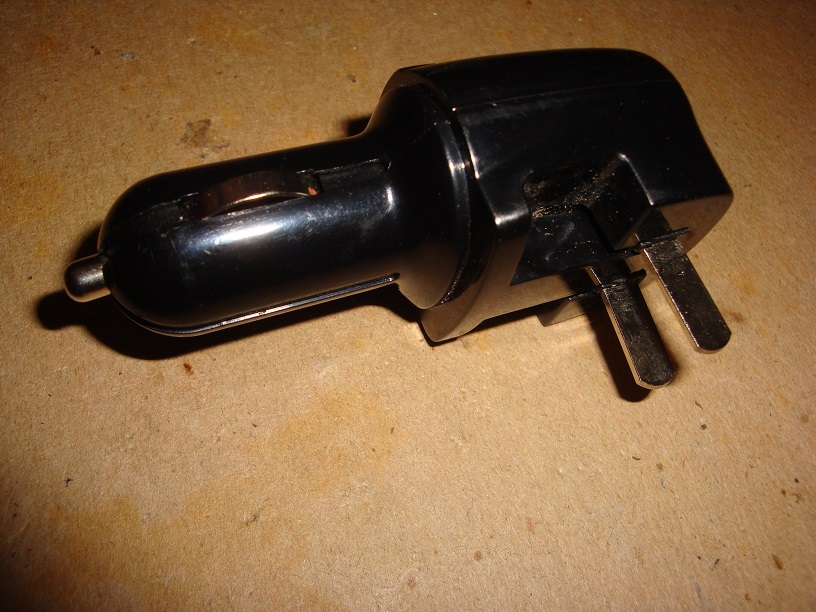
-
The LM338s I received from a China supplier were able to be used as
voltage regulators as long as one did not exceed 1 Amp current. The units
I bought were supposed to be able to provide up to 5A current. None of
the devices received could exceed one amp and several burned out during
my tests right around 1.0 Amp. The LM338 design is supposed to also
include a protection circuit to protect the part from burning out.
Photo Taken from the Web Page, link
below.
10PCS 5A LM338 LM338K Voltage Adjustable Regulator 1.2V To 32V
This particular part is on eBay but may be discontinued at any time.
The cost is very reasonable, perhaps too good to be true, less than $6 for
ten pieces. The one I bought was almost $3, did not work, I recieved a
refund, and is no longer available. Personally I would not trust this one
either.
-
Shake-to-Recharge Flashlight: This was another Hamfest special. On close
inspection I noticed that there was no circuit attached to the wire coil.
There should be a circuit that uses the generated electricity by a magnet
going through a coil of wire. However, there were clearly two batteries
inside. Also, the coil had no wires coming from it to a circuit. Last,
when I took the device apart, I found that the metal cylinder that moved
inside the coil of wire was not magnetic and was unable to produce any
electricity. By enlarging the image you can see a red wire going to the
two batteries. Noticed the circuit card. This card seems to have been made
to have a full-wave rectifier circuit to produce the charging electricity
for a real shake-recharge flashlight but there are no parts on the circuit
card.
Click on the Image to for a closer look
-
Bogus Li Rechargeable Batteries. Recently I found it difficlut to find
bogus 18650 Li rechargeable batteries on Amazon or eBay. I'm very happy
to say that the truly outrageous claims of 10,000 mAh or even higher are
no longer being made on Amazon. However, if you read my article you will
find that anything claiming above 3000 mAh will fall short of their claims
. The reputable manufacturer I contacted said that they were only able to
fit a bit more than 3000 mAh into that size package. Note: this may have
changed due to newer chemical formulations, but I'd have to test the
above batteries to see if their claims hold out. However, it is still
possible to find people advertising 18650 batteries with claimed higher
mAh ratings than is possible for this size battery. It is still common to
find these batteries being sold along with a flashlight now.
One on eBay This one looks like the bogus batteries I tested.
This next one from Amazon still claims more power than possible in an
18650 package:
One on Amazon Shows 9800mAh
If you read my article link below
you will find that anything claiming above 3000 mAh will fall short
of their claims. The reputable manufacturer I contacted said that they were
only able to fit around 3000 mAh into that size package.
Note: this may
have changed due to newer chemical formulations, but I'd have to test the
above batteries to see if their claims hold out.
At the time I bought about ten of these as gifts for use in flashlights,
but when I tested the ones I bought that claimed about 8000mAh, they
tested only to about 200 mAh. This was quite a difference! If someone was
unaware of what that difference meant, they probably would have said that
they do work. They did work, just not to the capacity they claimed. You can
see my evaluation article,
"Lithium Batteries are NOT all Created Equal!"
(2018) about some of these claims on my web site, click the link.
-
Liquid Battery Flashlight: This was a recent purchase from a company I've
been happy with over the years because when I find something that is not
as claimed, they have always refunded my money. In this most recent case,
they refunded my money and took my evaluation results and said that they
had taken the product off their web site until they could test them. This
product claimed to be a water-powered flashlight that would last up to 72
hours after a 5-second dip in water or some other liquid. The three units
I received did not come close to that, and all exhibited different kinds of
failures. I was able to break these apart in a way that was not destructive
and remove the water batteries. I replaced them with two AAA batteries and
all worked perfectly, thus leading to the conclusion that the water
batteries were defective.
NOTE:
The images on the right can be clicked on to view the larger image.
-
Bogus Cranking Rechargeable Flashlight - this was found recently and was
almost a complete knock-off of the bogus shaker rechargeable flashlight,
though a bit better. They tried to fool the buyer into believing that the
device did as they claimed, which was to recharge while being cranked. In
fact, it does not. When the crank was turned and the flashlight was off,
the LEDs would light up briefly for each crank. After further tests I
found that the cranking would not ever be able to charge a batter as
designed. In further tests, I noticed that if the flashlights were turned
off for an hour or more, they would then work again, even if they were not
cranked. This is also in line with a chemical one-time-use battery that
builds up its voltage and then works again for a much shorter time. I could
not understand why they would have it flash the LEDs during each cranking
while trying to charge the battery. This seemed like a wast of power. Why
run the LEDs when it made more sense to use that power to charge the
battery? This, too, led me to conclude that the "charging" circuit was for
show only. When I took two of these apart, I found three LR1130 Alkaline
1.5 V batteries that were running the LEDs. While the charging circuit did
actually work, at least to some degree, it would not be able to charge this
kind of battery since these were non-rechargeable Alkaline batteries.
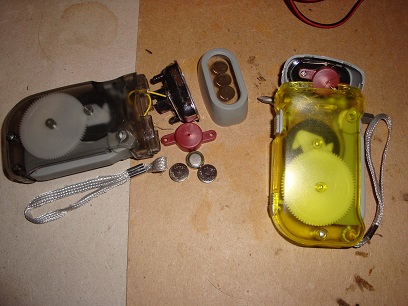
|
|
Click on the image to view a larger version.
|
-
Bogus Power-Saver Boxes - These boxes do not save power, or money,
because while they do improve the Power Factor for some electrical devices,
the power companies do not charge small consumers like us for a poor
power factor. They charge us for the Power in Watts (Kilowatts) used, and
the power in watts (kilowatts) does not change when these boxes are used.
You can read more about these bogus devices in my blog article on power
saver-boxes located at:

Power Saver Boxes Claims, Debunked
Click on the image to view my blog article:
|
Typical Power Saver Box, image from Amazon:
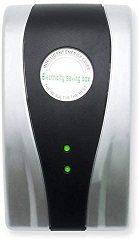
Click on the image
to view the Amazon
Offering.
|
Now, with all this said, and my debunking blog article behind you,
let me say that I have found a real use for these boxes.
We have had a problem with our
microwave on the same power line as our refrigerator. When trying to use
the microwave when the fridge is either working or starting up, the
combination throws the power line's circuit breaker. I put the "power
saver" box I made on this line two months ago now and have yet to have
the circuit breaker thrown since I did this. Capacitors are normally used
for just this purpose - to store excess power to be able to supply it for
higher current start-up times. What surprised me is that a mere 10 μf of
AC capacitance was able to solve this problem. So, if you're having this
kind of a problem and you have purchased one of these boxes, give it a
try on the problematic AC line.
Phil Karras / KE3FL 01/25/2021
|


